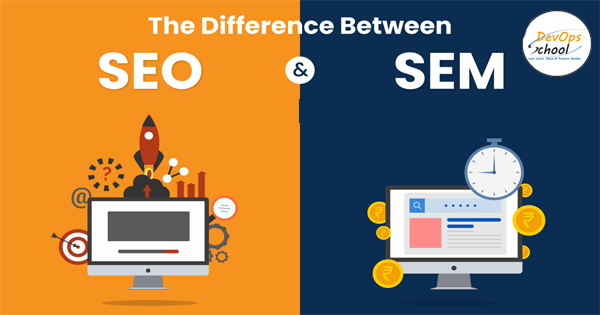
SEO and SEM are both digital marketing strategies aimed at increasing website visibility and driving traffic from search engines. However, they differ in their approaches and techniques. Here are the main differences between SEO (Search Engine Optimization) and SEM (Search Engine Marketing):
Definition and Focus:
SEO: Search Engine Optimization focuses on optimizing websites to improve organic (unpaid) search engine rankings. It involves optimizing website content, structure, and other factors to make it more search engine-friendly.
SEM: Search Engine Marketing refers to paid advertising on search engines. It involves running paid campaigns and bidding on keywords to display ads prominently in search engine results.
Cost:
SEO: It is primarily an organic strategy, meaning you don’t pay search engines for ranking your website. However, it requires investing time and effort in optimizing your website or hiring professionals to help you.
SEM: It involves paid advertising, where you pay for each click (CPC – Cost Per Click) or impressions (CPM – Cost Per Thousand Impressions). The cost can vary depending on factors like competition, keywords, and targeting.
Speed and Results:
SEO: It is a long-term strategy that takes time to show results. It requires continuous effort and optimization to improve rankings and gain organic traffic. The results may take weeks or months to materialize.
SEM: It provides immediate visibility and results as soon as you launch your paid campaigns. Once the campaign is set up, your ads can start appearing in search results and driving traffic instantly.
Placement in Search Results:
SEO: It focuses on improving organic search rankings to appear in the main search results (also known as SERPs – Search Engine Result Pages). SEO efforts aim to appear in the top organic positions below any paid ads.
SEM: It involves paid ads that are displayed separately from the organic results. Typically, SEM ads are shown at the top of search results or in a designated sidebar section.
Strategy and Approach:
SEO: It involves optimizing various on-page factors like keyword research, content creation, meta tags, site structure, user experience, and off-page factors like link building and social signals. The goal is to make the website more relevant and authoritative to search engines.
SEM: It focuses on creating effective paid campaigns using platforms like Google Ads, Bing Ads, or other search engine advertising platforms. It involves keyword selection, ad creation, bidding, and campaign optimization to drive targeted traffic.
Long-Term vs. Short-Term:
SEO: It is a long-term strategy that aims to build a strong online presence and improve rankings over time. Once your website gains visibility and authority, it can continue to drive organic traffic without ongoing advertising costs.
SEM: It is a short-term strategy that provides immediate visibility and traffic. As long as you continue to invest in paid campaigns, you can drive traffic and conversions. However, once you stop the campaigns, the traffic stops.
Both SEO and SEM have their advantages and can complement each other in a comprehensive digital marketing strategy. SEO provides long-term stability and free organic traffic, while SEM offers immediate visibility and control over targeting and messaging. The choice between the two depends on your goals, budget, timeline, and overall marketing strategy.
Digital Marketing Manager at Cotocus
